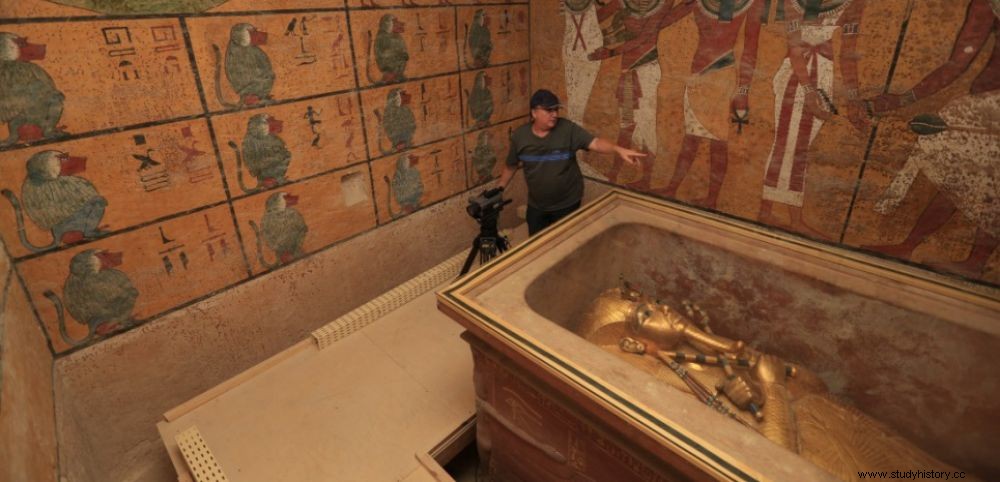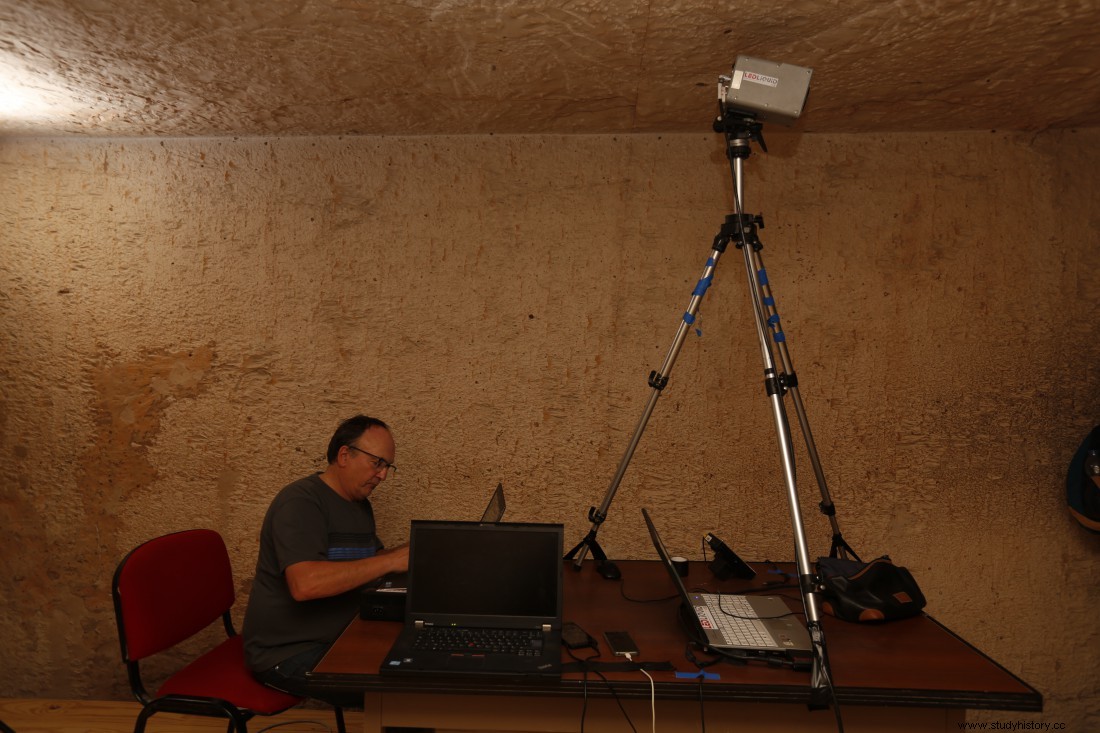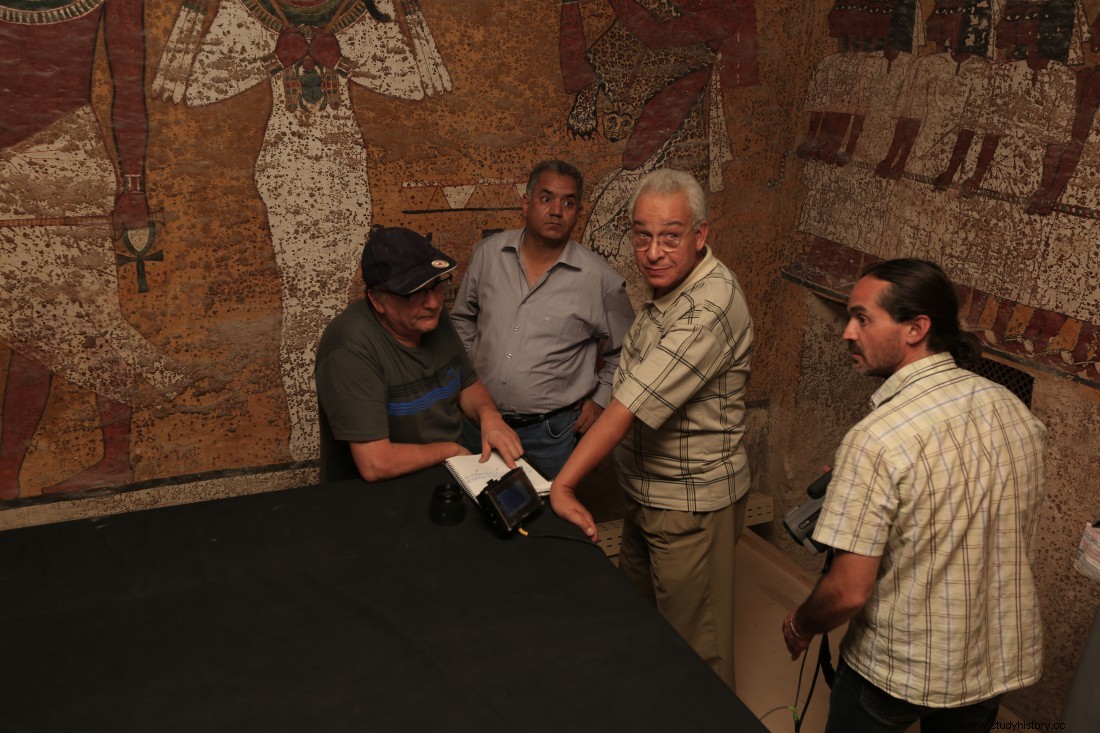 Jean-Claude Barré performs infrared measurements in the tomb of Tutankhamun on behalf of the French institute HIP and the Faculty of Engineering in Cairo
Jean-Claude Barré performs infrared measurements in the tomb of Tutankhamun on behalf of the French institute HIP and the Faculty of Engineering in Cairo THERMOGRAPHY. A difference in temperature of a few tenths of a degree, and here are the speculations that have surrounded Tutankhamun's tomb for a few weeks well revived! In a press release, Doctor Mamdouh Eldamaty, Egyptian Minister of Antiquities, announced the first results of the infrared thermography campaign carried out in the tomb of the little king in order to verify the hypothesis of a secret room put forward by the archaeologist British Nicholas Reeves. Infrared thermography is a non-destructive measurement method, which allows, by quantifying the variations of heat emitted by an object, to produce a heat map (see box at the bottom of the article). It is currently being used by the French institute HIP (Heritage, Innovation, Preservation) and the faculty of engineers in Cairo as part of the ambitious Scan Pyramids campaign, launched on October 25, to unlock the secrets of the funerary monuments of Giza. and Dashur.

Jean-Claude Barré performs infrared measurements within the tomb of Tutankhamun on behalf of the French institute HIP and the Faculty of Engineers of Cairo. © www.HIP.Institute / Philippe Bourseiller
For these ancient giants, it is a question of detecting possible areas with significant temperature differences on the surface, which could reveal cavities, chambers or corridors inside.
Exposed to the heat of the sun, the pyramids restore it differently depending on the presence of solid or hollow areas
Taking advantage of the presence on the ground of the Scan Pyramids teams, Mamdouh Eldamaty asked HIP to test the technique in Luxor, in the tomb of Tutankhamen. But the constraints encountered in this place confined by the two specialists, the Frenchman Jean-Claude Barré and the Quebecer Clémente Ibarra of Laval University, are very different from those of the desert plateaus where the colossi of the Old Empire are erected. "While the pyramids are exposed to the heat of the sun, which they render differently depending on the presence of solid or hollow areas, which allows us to refine our measurements, Tutankhamun's burial chamber is located under a land mass and in a region that varies little in temperature", explains Jean-Claude Barré. "There is no question of bringing energy or heat into such a fragile masterpiece. Nor of polluting it by too frequent passages of operators. All the measurements were therefore carried out by remote thermal cameras ."

From left to right:Dr. Mamdouh Eldamaty, Minister of Antiquities, Jean-Claude Barré, Prof. Hany Helal, Dr. Clemente Ibarra-Castanedo, French institute HIP (Heritage, Innovation, Preservation) and the faculty of engineers in Cairo. © www.HIP.Institute / Philippe Bourseiller
A team of twenty people, a battery of computers, and images captured at the rate of one every two minutes for twenty-four hours! The test was a concentrate of technology. The analyzes therefore showed a difference between the temperatures recorded through the plaster painted on different areas of the north wall which, according to Nicholas Reeves, would conceal the burial of Queen Nefertiti. "In order to confirm these preliminary results, said Mamdouh Eldamaty, a number of new experiments will be conducted to more reliably determine which part of the wall is showing a different temperature."
ZOOM on HIP
The HIP Institute, the French initiator of this ambitious mission, is a non-profit general interest structure, created in 2015. It is dedicated to the study, preservation and transmission of cultural heritage through the technological innovation. Its founders have been working for years to promote better collaboration between innovative disciplines. Hany Helal, first of all, professor at the faculty of engineers in Cairo, former minister of research and education, who was one of the pioneers of collaboration between engineers and archaeologists in Egypt. In particular, he participated in the EDF Foundation's microgravimetry campaign in Kheops just 30 years ago, which revealed under-density images, including a particularly intriguing spiral. François Schuiten, then, famous cartoonist, who inherited his passion for architecture from his father, and in particular worked on numerous scenographies around urban planning. Mehdi Tayoubi, finally. The president of the Institute is far from being unknown to history and archeology enthusiasts. For ten years, he directed "Passion for Innovation" at Dassault Systèmes, a structure whose objective was to put new technologies at the service of cultural projects, particularly archaeological ones:photogrammetric surveys of the wreckage of the Moon (read Science and Future 789, November 2012), 3D reconstructions of Parisian monuments that have disappeared and, already, of the Giza plateau with Harvard University. But also, in Egypt, development of the robot Djedi, with the University of Leeds, to explore the conduits of Cheops under the direction of Zahi Hawass, and simulation of an ingenious theory of construction advanced by the French architect Jean- Pierre Houdin:an interior ramp, running under the epidermis of the pyramid, which would solve the enigma of its construction. As a motto, the HIP Institute has chosen a phrase borrowed from the poet Aimé Césaire:"The shortest way to the future is always the one that goes through the deepening of the past".
READ ALSO.
With infrared and muons, Scan Pyramids will probe the heart of the pyramids. On October 25, 2015, the Egyptian Minister of Antiquities gave the green light to the exceptional scientific mission Scan Pyramids, which will focus on 4 pyramids. Story from Giza by our special correspondent Aline Kiner.
